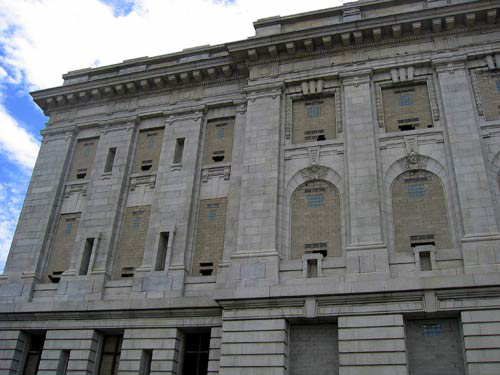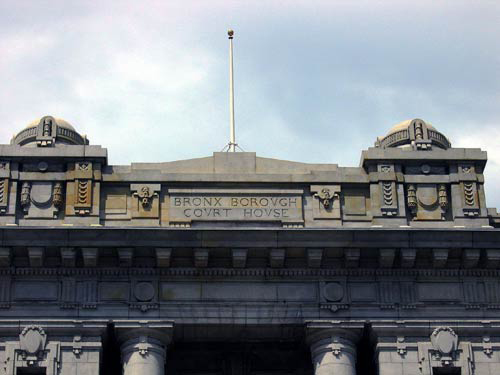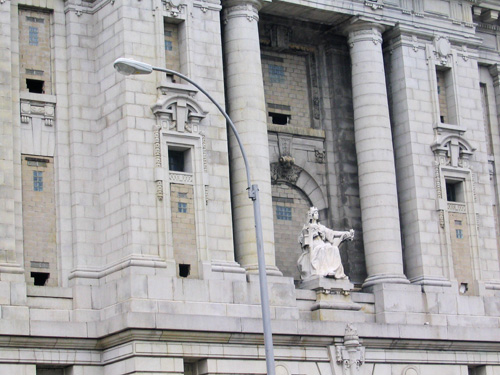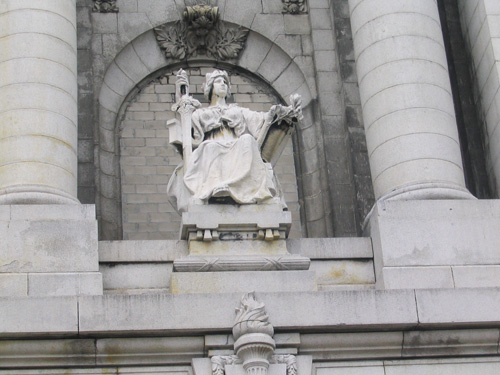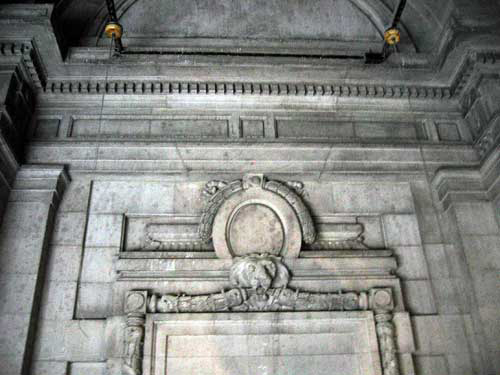Former Bronx
Borough Courthouse
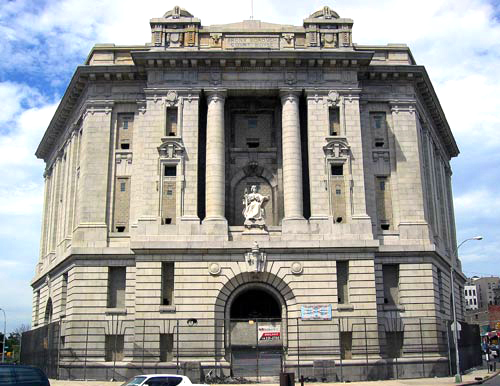
Between E. 161st St., Brook Ave., and Third Ave.
Oscar Bluemner (with Michael Garvin and Max Hausel)
1905-1914
The courthouse, a compact four-story mass of smooth granite, is divided almost evenly between a deeply rusticated two-story base and an upper portion where piers, pilasters and tall windows rise to a cornice and attic story. A preliminary sketch shows a high dome and cupola, never built, which would have visually absorbed the upthrust and perhaps more satisfyingly resolved the relation of vertical and horizontal. To fit its site, the building is trapezoidal in plan, narrowing toward the side facing down Third Avenue. This façade is penetrated at ground level by a great arched portal scooped out of the heavy stonework. Above it, the façade retreats into a deep bay flanked by two colossal cylindrical columns, between which is poised Jules Eduard Roiné’s larger-than-life-sized marble statue of Justice. Behind her, on the rear wall of the recess, the arch of the lower portal is repeated as a window frame, surmounted by a lion’s-head keystone.
In this Third Avenue front, and its variations on the other sides of the courthouse, very familiar elements of Beaux-Arts classicism have been used with restraint to construct a powerful architectural emblem—the force and threat of the Law represented below, its rationality and self-control above. In compensation for its structural austerity, the Third Avenue façade is enlivened by sharply chiseled geometrical inventions. Intricate frames, stylized swags, and complicated broken pediments surround the windows, some of which puncture the wall with unusually deep, shadowy apertures. Thick bullet-headed finials top the attic. There is even a motif—a set of three classical guttae (or “drops”)—which appears with witty persistence in all sorts of unexpected positions. The total effect is strikingly modern, in the manner of Viennese and Parisian buildings of the period, and very unlike New York’s turn-of-the-century architectural ornament.
How did the Bronx come by this remarkable Beaux-Arts building? By accident.
In 1903, the first President of the borough, Louis Haffen, passed on the contract for a courthouse design, worth $40,000, to his political right-hand-man, Michael Garvin. (“If you have the pull,” Garvin acknowledged later, “you get the work.”) Haffen was only following the Tammany tradition of rewarding loyalty with fat public works assignments. But his friend (despite serving as Building Commissioner) proved to have such limited architectural skills that his plans were rejected by the New York Art Commission, which derided them as “egregious” and “despicable.” The unfortunate Garvin was forced to seek out an underemployed architect, offering to share fees and credit in return for an acceptable building.
That he turned to Oscar Bluemner, a German émigré who had been a prize student at Berlin’s Royal Academy, was a stroke of fortune for Bronx architecture. But not for Bluemner: when the drawings had been prepared, Garvin submitted them as his own work, and ignored both promised credit and payment. The outraged Bluemner sued and won, his testimony leading to an investigation, which eventually resulted in Haffen’s dismissal. Bluemner, however, was awarded only about one-quarter of the amount he felt he was owed, and forced to allow Garvin main credit for the building; in disappointment, he gave up his profession a short while later, and turned to painting. Official records—even those of the Landmarks Commission—continued to attribute the courthouse to Garvin.
Like its designer, the building itself suffered from the political environment. Construction, begun in 1905, was drawn out until 1914, and cost two million dollars, more than twice the original estimate. (Not coincidentally, Garvin remained as supervising architect through the project.) By 1934 the county had found reasons to build a new courthouse, eventually leaving only a police court at the Third Avenue site. When the building was officially closed by the city in 1977, vandals undertook the stripping of its metalwork until all doorways and windows were sealed with concrete blocks (leveling off Bluemner’s deep embrasures). Although a 1981 designation as a landmark helped protect the courthouse from threatened razing, serious repairs have never been undertaken: the building is currently on the Landmarks Conservancy's most endangered list. And lively plans for occupancy by community design and museum groups were thwarted when the courthouse was sold to a private developer for a derisory $130,000.
But things may be looking up. The new owner has performed a much-needed exterior cleaning—the Tammany-purchased granite having begun to yellow even before the building was completed—and found a tenant. Meanwhile, after revival of critical interest in his paintings led to a 2005 show at the Whitney Museum, the imaginative Oscar Bluemner is at last being acknowledged as author of this sophisticated public building.
David Bady
Photographs:
Lehman College Art Gallery and David Bady


